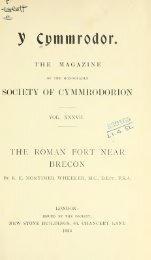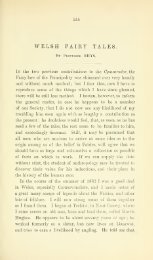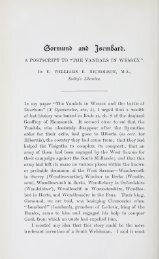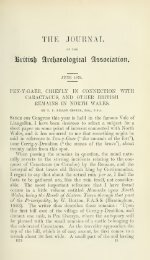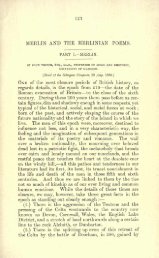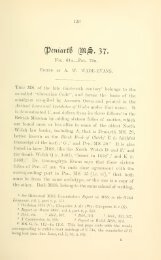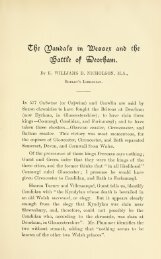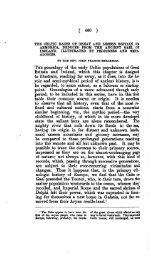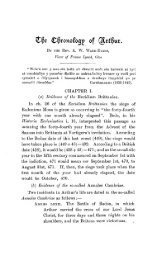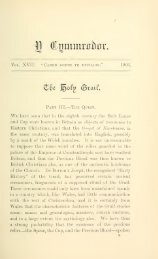An Introduction to Early Welsh - Arthur Pendragon of Wales
An Introduction to Early Welsh - Arthur Pendragon of Wales
An Introduction to Early Welsh - Arthur Pendragon of Wales
Create successful ePaper yourself
Turn your PDF publications into a flip-book with our unique Google optimized e-Paper software.
16.]<br />
CONSONANT MUTATIONS. 13<br />
there are some instances <strong>of</strong> lenation after mwy more. After the<br />
superlative in RB. non-lenation seems <strong>to</strong> be the rule in RB. II. lenation<br />
;<br />
is more frequent.<br />
NOTE 6. In Celtic, when the adjective preceded the noun, it formed a<br />
compound with it, e.g. hen-wrach old hag ( 34a), and in composition the<br />
lenation <strong>of</strong> the second element was regular, e.g. eur-wisc golden dress,<br />
bore-vwyt morning-food, breakfast. In <strong>Welsh</strong>, when the adjective came<br />
<strong>to</strong> be used freely before the noun, the lenation <strong>of</strong> the old compounds was<br />
retained in the positive,<br />
NOTE 7. On the analogy <strong>of</strong> lenation in compound words and <strong>of</strong> lenation<br />
<strong>of</strong> the noun following the adjective, in poetry, when the genitive precedes<br />
the noun, it may lenate, e.g. byd lywyadwr the ruler <strong>of</strong> the world, o Gymry<br />
werin <strong>of</strong> the host <strong>of</strong> the Cymry.<br />
(p) When an adjective is repeated, e.g. mwy vwy vyd greater<br />
and greater will be.<br />
(d) After YN forming adverbs, and with predicative<br />
nouns and adjectives ( 35), e.g. yn vynych <strong>of</strong>ten, yn borth<br />
as a help, yn wreic as a wife. But yn llawen gladly ( 15).<br />
NOTE 8. With regard <strong>to</strong> their influence upon a following word it is<br />
necessary <strong>to</strong> bear in mind that predicative yn lenates, that yn in is<br />
followed by the nasal mutation ( 20b) and that yn with the verbal noun,<br />
e.g. yn mynet going ( I26a), does not affect a following consonant.<br />
(e)<br />
(a)<br />
After numerals.<br />
After cardinal numbers.<br />
un one. After the fern., lenation seems <strong>to</strong> be regular, e.g. un<br />
wreic one woman, un vil one thousand, yr un gerdet the same<br />
going. Initial 11 is regularly uninfected, e.g. un llynges one fleet.<br />
After the masc. the usage seems <strong>to</strong> vary, e.g. vn geir one word RB.<br />
197 = WB. 123, but vn eir RB. II. 222, yr un march the same<br />
horse RB. 9, but neb vn varchawc any horseman RB. II. 278, yn<br />
un uaes in one field RB. 114.<br />
NOTE 9. In Irish, din regularly mutates a following consonant.<br />
According <strong>to</strong> Rowlands, Mod.W. un mutates in the fern.<br />
deu, dwy two. After these lenation is regular, e.g. deu<br />
barchell two pigs, deu lu two hosts, dwy verchet two daughters.<br />
But deu cant two hundred RB. II. passim.<br />
chwech, chwe six : chwech wraged six women RB. 18, 16 ;<br />
but chwe blyned six years RB. II. 387, 404.<br />
Seith seven : seith gantref seven cantreds RB. 25, 44, seith<br />
gelfydyt seven arts RB. II. 200, seith wystyl seven hostages RB.




